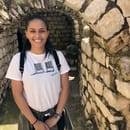“Where are you from?” As a child, I had grown up in predominantly white schools and never saw the multiple sides of who I was. When people first look at me, they think I’m black, but when I used to look at myself in the mirror, I was white. I grew up going to a Jewish private school where my brother and I were the few students of color. Growing up in a Jewish day school had its challenges, as I was constantly faced with questions regarding my identity and background. “Where are you from” followed by, “No, but where are you reallyfrom?” Boston was always the answer. In fifth grade, I thought a switch to public school might change that.
I was never taught black history, and solely learned about the white America that we live in today. I couldn’t bring myself to share both the white and black sides of my identity until my sophomore year of high school. I grew up in a life of privilege, as my highly educated white mother and black father gave both my brother and me the opportunities that many black kids in the surrounding affluent neighborhoods had.
“You’re the whitest black-girl I know.” As a high school sophomore, I came to realize that school assemblies were the only way of getting information on what my peers thought it was like to live in a white world. I vividly remember, and still do feel discomfort, when topics of black history come up in class and my white peers turn to me to represent black America as a whole. I often felt like my voice was hidden when feelings of invisibility circulated in my head. I became afraid to raise my hand and share personal experiences and stories in fear that my answer was “wrong” or not what my classmates and teachers wanted to hear. I didn’t want to fit the stereotype of a “black girl,” but also didn’t want to erase an important aspect of my identity. Out of these uncomfortable experiences, I have learned to embrace the fact that people will not always agree or understand what I’m talking about.
“American Indian, Asian, Black or African American, Pacific Islander, White.” There was never a “two or more races, biracial, or multi-racial” box to click. My whole life I struggled with having to choose between letting one side of my identity go in order to get a job or apply for college. As an incoming freshman, I remember hearing the words, “Your class is the most diverse one yet.” Confident and untouchable, I was determined to find my group of peers with many different backgrounds. In entering college, I found myself contemplating which clothes to wear and how to wear my hair each day. Which aspects of how I dressed would represent my white side and which would represent the black side of my identity? It wasn’t until a few months ago, that I realized that these were things that only I cared about. While I do realize college is a place where people of all different backgrounds can come together, I find myself solidifying and staying connected with white friends-something I have just grown to find comfort in. While I can’t change my identity, I am proud to call myself a biracial woman.


